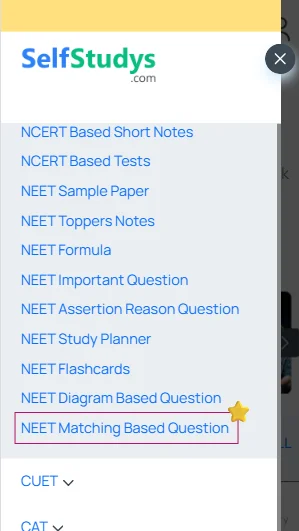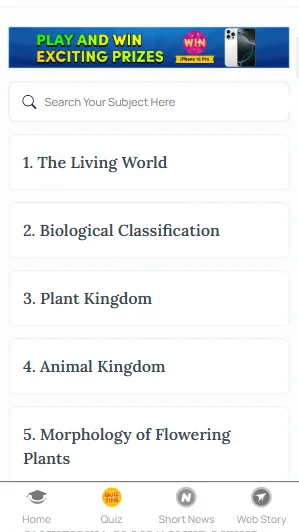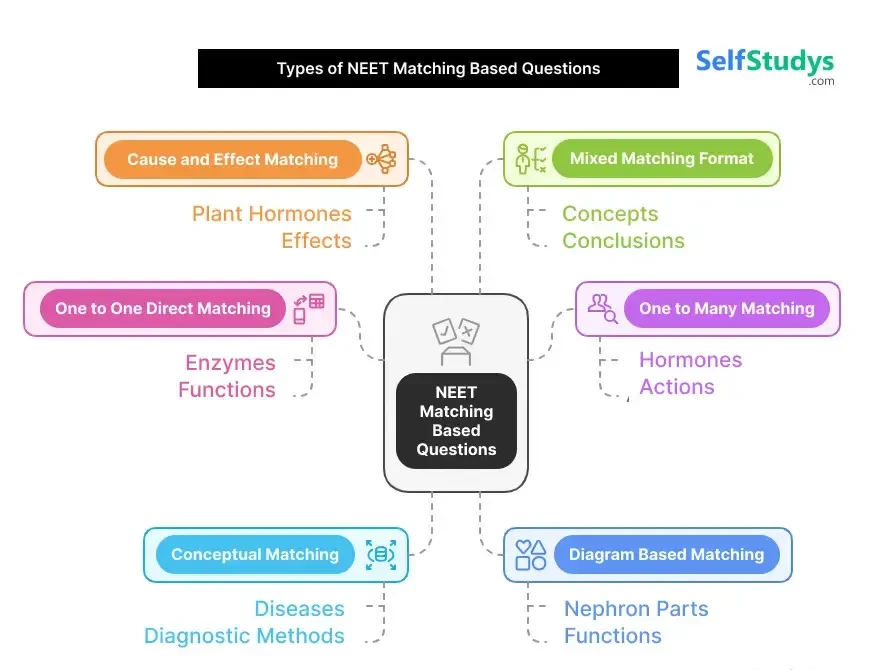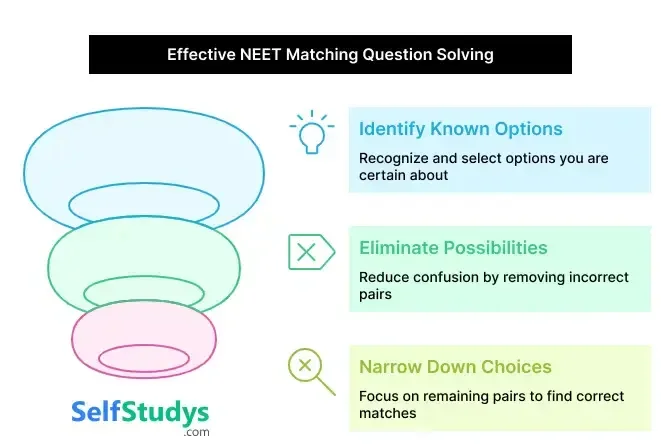- 1. The Living World
- 2. Biological Classification
- 3. Plant Kingdom
- 4. Animal Kingdom
- 5. Morphology of Flowering Plants
- 6. Anatomy of Flowering Plants
- 7. Structural Organisation in Animals
- 8. Cell The Unit of Life
- 9. Biomolecules
- 10. Cell Cycle and Cell Division
- 11. Transport in Plants
- 12. Mineral Nutrition
- 13. Photosynthesis in Higher Plants
- 14. Respiration in Plants
- 15. Plant Growth and Development
- 16. Digestion and Absorption
- 17. Breathing and Exchange of Gases
- 18. Body Fluids and Circulation
- 19. Excretory Products and their Elimination
- 20. Locomotion and Movement
- 21. Neural Control and Coordination
- 22. Chemical Coordination and Integration
- 23. Reproduction in Organisms
- 24. Sexual Reproduction in Flowering Plants
- 25. Human Reproduction
- 26. Reproductive Health
- 27. Principles of Inheritence and Variation
- 28. Molecular Basis of Inheritance
- 29. Evolution
- 30. Human Health and Disease
- 31. Strategies for Enhancement in Food Production
- 32. Microbes in Human Welfare
- 33. Biotechnology Principles and Processes
- 34. Biotechnology and its Applications
- 35. Organisms and Populations
- 36. Ecosystem
- 37. Biodiversity and its Conservation
- 38. Environmental Issues
Through these questions, the examiners check your ability to connect related concepts, analyze the information, and apply your understanding in a smart way.
At SelfStudys, we provide a very good collection of NEET matching-based practice questions. You can solve these questions free of cost to sharpen all the important skills. So, whether you are just starting your preparation or doing final revisions, this set of questions will help you reinforce the concepts easily.
Why Are NEET Matching Based Practice Questions Important?
The matching-based questions for NEET are asked by to test your conceptual clarity which is why, there practice is very important. We have described some more points on their importance in detail below.
-
The NEET matching-based questions PDF never ask for just rote memorization. Instead, your understanding of relationship between concepts is tested. For example, you need to match hormones with their functions, or diseases with causing agents. So, these questions check your layers of knowledge and not just isolated facts.
-
Subjects like Biology and Chemistry are quite connected with each other. The NEET matching-based questions PDF download combines two topics which forces you think across the chapters. This way, you will be able to solidify your long-term retention and answer the questions accurately.
-
With good preparation, you can solve the NEET matching-based questions very quickly. As these are typically objective type problems and don’t require calculations, you get a great chance to score marks with speed.
-
These NEET matching-based practice questions mirror the real-world process of knowing relationships. Through this learning process, you are more aligned with the real-life application of knowledge.
Subject-Wise NEET Matching Based Questions
For better exam preparation across all the subjects, we provide you with subject-wise NEET matching-based questions. By solving them, you can have mastery over each subject and score higher marks in the exam as well. You can use the links given below to access subjects questions on our platform.
| Sr No | NEET Matching Based Questions |
|---|---|
| 1 | NEET Biology Matching Based Question |
| 2 | NEET Physics Matching Based Question |
| 3 | NEET Chemistry Matching Based Question |
Matching Based Questions For NEET With Solutions
All the matching-based questions for NEET are accompanied by detailed solutions and explanations on our platform. With these explanations, you are able to know the correct reasoning behind the questions and improve your knowledge. Our experts spend many hours on creating the right answers for your sole benefit. We recommend that you first solve all the questions and then cross-check your responses with the solutions that are provided.


How To Access The NEET Matching Based Questions PDF On SelfStudys?
Here is the full procedure that will help you to get your hands on our NEET matching-based questions PDF. You just need to have a good internet connection to succeed in this process.
- The first step is to open an internet browser on your preferred device and type www.selfstudys.com in its search space.

- Our homepage had a very user-friendly interface where you can easily find the ‘Navigation’ bar and click on it.
- Under this bar, the main menu of our website will open up. Here, you need to select the ‘NEET’ section.

- This section will further showcase a variety of related study materials and you can click on the ‘NEET matching-based questions’.

- Now, a list of all the chapters for NEET matching-based questions PDF download will be available.

- You can choose any chapter’s NEET matching-based practice questions and go through the PDF in normal or HD quality.
- Finally, you can download your chosen matching-based questions for NEET and practice them effectively.
Note: A Gmail ID Log In or Sign Up should be done for the downloading purposes of the NEET matching-based questions PDF.
Types Of NEET Matching Based Questions Encountered In The Exam
Below is a table in which we have mentioned the different formats of NEET matching-based questions that are asked mostly in the NEET previous year question papers.

| TYPE | MEANING | EXAMPLE | IMPORTANCE |
|---|---|---|---|
|
One to One Direct Matching |
This is the simplest format, where each item in Column A has exactly one correct match in Column B. |
Match the enzymes (Column A) with their functions (Column B). A. Amylase → 1. Breaks down starch B. Lipase → 2. Breaks down fats C. Pepsin → 3. Breaks down proteins |
It checks foundational knowledge, often from NCERT diagrams or tables. |
|
One to Many Matching |
Each term in Column A may have more than one correct match in Column B. |
Match the hormones (Column A) with their multiple actions (Column B). A. Insulin → 1. Lowers blood glucose, 2. Promotes glycogenesis, 3. Inhibits gluconeogenesis |
Tests your ability to recall multiple facts about a single concept—important for physiology and biochemistry. |
|
Conceptual Matching |
Requires understanding, not just memory. You match based on underlying logic or real-life application. |
Match diseases (Column A) with the diagnostic method or test (Column B). A. Diabetes → 1. HbA1c B. Tuberculosis → 2. Mantoux Test C. Malaria → 3. Blood Smear Test |
Reflects NEET’s shift to competency-based questions and application of knowledge. |
|
Diagram Based Matching |
You’re given diagrams (often from NCERT) and asked to match labels with structures or functions. |
Match the parts of a nephron in a labeled diagram with their corresponding functions. A. PCT → 1. Reabsorption of glucose and amino acids B. Loop of Henle → 2. Concentration of urine |
Visual learning questions test your ability to connect images with theory. |
|
Cause and Effect Matching |
You match a condition or stimulus with its biological effect or outcome. |
Match plant hormones (Column A) with their effects (Column B). A. Auxin → 1. Cell elongation B. Cytokinin → 2. Cell division C. Abscisic Acid → 3. Stomatal closure |
This format checks whether students understand cause-and-effect relationships. |
|
Mixed Matching Format |
A slightly advanced version where two-column matching is mixed with an assertion-reason type logic. |
Match concepts (Column A) with related conclusions (Column B), and identify if the match leads to a valid biological inference. A. Hypersecretion of GH → 1. Acromegaly (Valid inference: Yes/No?) B. Lack of insulin → 2. Hyperglycemia (Valid inference: Yes/No?) |
Tests analytical skills and logical deduction, often used in higher-difficulty level questions. |
Most Important Topics Covered In The NEET Matching Based Questions PDF Download
Most of the NEET matching-based practice questions are based on the Chemistry and Biology subjects. But some of them are also created from the Physics subject. In the table below, we have mentioned the topics that are most important to study for this question type.
| SUBJECT | IMPORTANT TOPICS |
|---|---|
|
Biology |
Plant Kingdom and Animal Kingdom
|
|
Plant Morphology and Anatomy
|
|
|
Cell- The Unit of Life
|
|
|
Human Physiology
|
|
|
Plant Physiology
|
|
|
Genetics and Evolution
|
|
|
Ecology and Environment
|
|
|
Biotechnology and Microbes in Human Welfare
|
|
|
Chemistry |
Periodic Table and Properties
|
|
Chemical Bonding
|
|
|
Organic Chemistry
|
|
|
Biomolecules and Polymers
|
|
|
Coordination Compounds
|
|
|
Physics |
|
Note: You must be aware that the matching-based questions for NEET are picked from the classes 11 and 12 NCERT tables, charts, as well as diagrams directly.
How To Solve Matching Based Questions For NEET Effectively?
The subject-matter experts at SelfStudys have suggested some ways with which you can solve the NEET matching-based questions PDF in an effective manner.

-
In the NEET matching-based questions PDF download, you should start by finding the options that you are absolutely sure about. By doing so, you can reduce any confusion and narrow down the possibilities of the remaining pairs.
-
If you are not sure about a particular match in the NEET matching-based questions, then you should go through every choice and remove the incorrect options in a systematic way. In this way, you will be able to increase the chances of selecting the correct match.
-
Before you jump into matching the pairs, you should scan through all the options in both columns that are given in the NEET matching-based practice questions. You must know that sometimes a single option in one column can match with more than one in the other column.
-
The matching-based questions for NEET is not always based on rote memory. These questions check your understanding of how two items relate. So, always focus on learning the ‘why’ behind every match.
-
You need to practice the NEET matching-based questions PDF from past papers in order to understand their pattern and complex nature. This way, you can get insights into the mindset of the examiner as well as boost your familiarity.
Conclusion
The NEET matching-based questions PDF download might look quite simple but it plays a very important role in testing how well you understand and connect the concepts. With thorough practice of these questions, you can become faster in solving them than any other question types. This will give you more time to solve challenging problems in the real exam. So, you should add them to your daily revision and practice on a regular basis. Then, you will start seeing improvement in your speed and accuracy for sure.







 Profile
Profile Signout
Signout










 Quiz
Quiz
 Get latest Exam Updates
Get latest Exam Updates 










